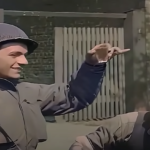Watch Footage of the Allies Rolling Through a Defeated German Town in April, 1945: Restored & Colorized with AI


Early April, 1945. The Soviets are closing in on Germany, liberating Warsaw, Krakow, and Budapest. American troops have crossed the Rhine. Adolf Hitler won’t live to see May. World War II is coming to an end. This footage, taken from film by American troops in and around Nordhausen, Germany, shows the wreckage of a defeated nation. Enhanced by AI into 60fps, with color and atmospheric sound added, it’s another of YouTube’s increasing library of old footage that looks like it was shot yesterday. (Unfortunately, the video has changed the film’s ratio, widening all the humans in it.)
The original film—you can watch it here at the United States Holocaust Memorial Museum—has an interesting history itself. Shot by a member of the US Army Signal Corps, the film was kept in the National Archives and Records Administration until being unearthed by Douglas Hackney while researching his grandfather who served in the war. (Apparently he is seen in one of the other films in the original collection.) The digitization was then gifted to the Holocaust Memorial Museum.
The 60fps version is assembled from several reels. We see fighting in a forest outside Nordhausen, then a gathering of captured Nazi soldiers, then troops celebrating with freed prisoners with some shots of liquor, a bit of morning downtime, and the effects of allied bombing.
Nordhausen was the sight of the Dora-Mittelbau concentration camp, built in August of 1943 so Nazis could use its prisoners as slave labor, digging tunnels into the nearby hillside for German factories related to the V-2 rocket program.
According to the Holocaust history website, remember.org:
On April 11th, the 104th Infantry Division entered the Dora camp and the 3rd Armored Division entered the Boelcke-Kaserne subcamp. Although members of the VII Corps had been forewarned there was a prison camp, they certainly could not have expected the inhumane atrocities they were about to witness. The dead and near-dead were everywhere, piled upon one another, and immediate medical attention was given to the few survivors. There were 3000 corpses and 750 emaciated survivors that were abandoned by the SS.
Of the 60,000 prisoners to enter the Dora-Mittelbau camps, it is estimated that 13,000-18,000 died in the camp. Common causes of death included tuberculosis, pneumonia, starvation, dysentery, and trauma.
One can hope these 60fps enhanced videos continue to be uploaded to YouTube. Personally, the colorization adds little, but as a window into time really not that long ago (and with neo-Nazis still kicking around) we need reminders of where it can all lead without our vigilance.
Related Content:
Real D-Day Landing Footage, Enhanced & Colorized with Artificial Intelligence (June 6, 1944)
Dramatic Footage of San Francisco Right Before & After the Massively Devastating Earthquake of 1906
Watch the Only Known Footage of Anne Frank
Ted Mills is a freelance writer on the arts who currently hosts the Notes from the Shed podcast and is the producer of KCRW’s Curious Coast. You can also follow him on Twitter at @tedmills, and/or watch his films here.
Watch Footage of the Allies Rolling Through a Defeated German Town in April, 1945: Restored & Colorized with AI is a post from: Open Culture. Follow us on Facebook and Twitter, or get our Daily Email. And don't miss our big collections of Free Online Courses, Free Online Movies, Free eBooks, Free Audio Books, Free Foreign Language Lessons, and MOOCs.
from Open Culture https://ift.tt/3qUA3Uu
via Ilumina

Comments
Post a Comment